Who was Dian Fossey? Dian Fossey was an American primatologist who dedicated her life towards the protection and conservation of Mountain gorillas. She was involved in continuous research about all issues related to mountain gorillas within the Virunga mountains including how to habituate them. Dian Fossey was also the founder of the famous Karisoke Research Center of Rwanda. Born in 1932 at San Francisco California, little Dian Fossey was already fond of animals. She started learning how to ride horses by age 6. Fossey spent part of her early life working in a ranch in Montana and this experience saw her develop a greater attachment to animals.
Upon that background, she felt the need to study a pre-veterinary course which she pursued from the University of California. Some of the courses she undertook during the program where challenging and 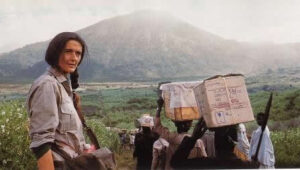 she decided to focus on occupational therapy at San Jose state college where she graduated in 1954.
she decided to focus on occupational therapy at San Jose state college where she graduated in 1954.
Dian Fossey started working at the Kosair Children’s Hospital, a job she later quit in order to focus on researching about wild mountain gorillas. Dian Fossey’s dream of visiting Africa started after her friend had just been to Africa. She shared many interesting stories about her trip and also showed Fossey the photographs she had taken. Despite not having enough money to finance her trip, Dian Fossey decided to take a bank loan to finance her initial trip to Africa.
Dian Fossey and Her Maiden Trip to Africa
Dian Fossey finally set foot in Africa where she visited the countries of Kenya, Congo (Zaire by that time) and Tanzania (formerly Tanganyika) with the help of a British hunter known as John Alexander. While in these countries, Dian Fossey visited Tsavo national park of Kenya, Ngorongoro Crater of Tanzania and Olduvai Gorge which was the archaeological site of Louis and Mary Leakey. She also visited Mount Mikeno of Congo where an American Zoologist known as George Schaller was conducting research on the wild mountain gorillas. George Schaller’s initial work later helped simplify Dian Fossey’s work with mountain gorillas.
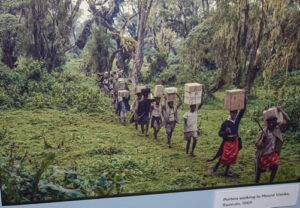 The major turning point in Dian Fossey’s trip to Africa was visiting Dr Louis Leakey at the Olduvai gorge in Tanzania. Dr. Leakey encouraged her to pursue her dreams of studying wild gorillas citing examples of other primatologists who had embarked on a similar mission and had registered great success. He gave the example of Jane Goodall who had been studying wild chimpanzees in Tanzania for almost 3 years by that time. Dr. Leakey showed her around the archaeological sites at Olduvai Gorge before she made her way to Congo. In Congo, Fossey met Allan and Joan Root who were working on a video documentary about the wild gorillas of Congo’s Virunga mountains. The couple welcomed her and introduced her to the jungles of the Virunga mountains. She tracked gorillas with them and took some photographs. This first experience with the primates helped prepare her for a career as a primatologist. Fossey left Africa and went back to Kentucky where she continued with her job at the Kosair Children’s hospital. Africa never left her mind and she published articles/photos about all the experiences she had from her maiden trip to the continent.
The major turning point in Dian Fossey’s trip to Africa was visiting Dr Louis Leakey at the Olduvai gorge in Tanzania. Dr. Leakey encouraged her to pursue her dreams of studying wild gorillas citing examples of other primatologists who had embarked on a similar mission and had registered great success. He gave the example of Jane Goodall who had been studying wild chimpanzees in Tanzania for almost 3 years by that time. Dr. Leakey showed her around the archaeological sites at Olduvai Gorge before she made her way to Congo. In Congo, Fossey met Allan and Joan Root who were working on a video documentary about the wild gorillas of Congo’s Virunga mountains. The couple welcomed her and introduced her to the jungles of the Virunga mountains. She tracked gorillas with them and took some photographs. This first experience with the primates helped prepare her for a career as a primatologist. Fossey left Africa and went back to Kentucky where she continued with her job at the Kosair Children’s hospital. Africa never left her mind and she published articles/photos about all the experiences she had from her maiden trip to the continent.
Dian Fossey’s Second Trip to Africa and the establishment of the Kabara Camp (1966-1967)
Having moved back home after her first trip, Dian Fossey again met Dr. Louis Leakey during his lecture in Louisville. They had a discussion which encouraged Dr. Leakey to consider Dian Fossey for a project to study primates in the jungles of Africa after securing funds.
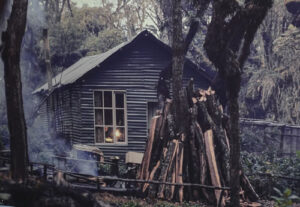 Dian Fossey made her second trip to Africa in December 1966, 8 months after the meeting with Leakey in Louisville. Her objective was to study gorillas in the jungles of Africa. Her initial research activities were concentrated in Congo’s Virunga mountains where Allan Root helped her to acquire the working permits and other necessary approvals for her research activities. Allan also helped her find local people to help her out at her camp on the Kabara meadows. With the help of her colleagues, she was able to identify 3 gorilla groups on the slopes of Mt Mikeno and begun the process of habituating them. In no time, the gorillas had become comfortable with her presence. Dian Fossey discovered many things about the gorilla habituation process.
Dian Fossey made her second trip to Africa in December 1966, 8 months after the meeting with Leakey in Louisville. Her objective was to study gorillas in the jungles of Africa. Her initial research activities were concentrated in Congo’s Virunga mountains where Allan Root helped her to acquire the working permits and other necessary approvals for her research activities. Allan also helped her find local people to help her out at her camp on the Kabara meadows. With the help of her colleagues, she was able to identify 3 gorilla groups on the slopes of Mt Mikeno and begun the process of habituating them. In no time, the gorillas had become comfortable with her presence. Dian Fossey discovered many things about the gorilla habituation process.
Just as she was getting settled at her Kabara camp and her efforts were starting to pay off, there was an escalation of civil conflicts in the Kivu region of Congo. This forced her to abandon the Kabara camp to go seek refuge at the Rumangabo military camp where she stayed for about 14 days before she fled to Kisoro in Uganda. Despite backing off for a while, Dian Fossey was determined not to allow anything stop her mission in Africa. She decided to continue her gorilla research activities from the Rwandan side of the Virunga mountains which was much safer.
Establishment of the Karisoke Research Center
Upon moving to Rwanda, Dian Fossey met a lady known as Rosamond Carr who had lived in the country for a long time and knew it well. Rosamond introduced Dian Fossey to a Belgian lady who born in the Congo but had migrated to Rwanda for security reasons. She was known as Alyette De Munck. Alyette helped Dian Fossey to find a good site to set up her new camp which was completed on September 1967. Dian named her new came “Karisoke”. “Kari” was from the first 4 letters of Mt. Karisimbi which directly faced her camp from the south and then ”Soke” from the last 4 letters of Mt. Bisoke whose slopes were just behind her camp.
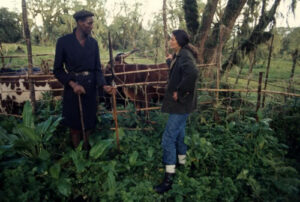 While at her new camp, Dian Fossey faced a few major challenges including language barrier. Her workers could only speak Kinyarwanda while she could only speak Kiswahili. She got work done by using sign language until she was able to say a few words. She also faced more difficulty habituating gorillas on this other side of the Virunga mountains because the primates kept fleeing from her whenever she tried to reach them. The gorillas in this part of the Virunga Ranges were afraid of humans because of their bad experience with poachers and pet traders. Poachers often killed the gorillas to capture the young for sale.
While at her new camp, Dian Fossey faced a few major challenges including language barrier. Her workers could only speak Kinyarwanda while she could only speak Kiswahili. She got work done by using sign language until she was able to say a few words. She also faced more difficulty habituating gorillas on this other side of the Virunga mountains because the primates kept fleeing from her whenever she tried to reach them. The gorillas in this part of the Virunga Ranges were afraid of humans because of their bad experience with poachers and pet traders. Poachers often killed the gorillas to capture the young for sale.
Poaching of gorillas in Rwanda made Fossey become an active conservationist. She would spray paint cattle that came grazing within the protected areas of her research camp. Fossey also burnt snares set up by poachers and would often confront them directly which was a risky move considering that the poachers were capable of threatening her own life. Dian Fossey used the resources at her disposal to purchase uniforms, boots and other necessary items for Rangers she had recruited to help fight off poachers while on patrol.
Digit the Favorite Gorilla
While at Karisoke center, Dian Fossey developed a close connection with a silverback gorilla called Digit. Digit appeared in several photo shoots with her and hence became an ambassador for gorillas that she 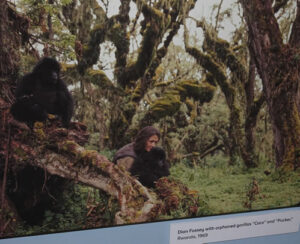 studied. Digit was later brutally murdered by poachers in 1977 which left Dian Fossey so broken and lone. Dian Fossey created the Digit fund to help raise finances to help fight poaching of gorillas and also to raise awareness about the importance of conserving the primates. The Digit fund was later renamed Dian Fossey Gorilla fund in memory of her great efforts towards the protection and conservation of mountain gorillas.
studied. Digit was later brutally murdered by poachers in 1977 which left Dian Fossey so broken and lone. Dian Fossey created the Digit fund to help raise finances to help fight poaching of gorillas and also to raise awareness about the importance of conserving the primates. The Digit fund was later renamed Dian Fossey Gorilla fund in memory of her great efforts towards the protection and conservation of mountain gorillas.
Dian Fossey wrote and published a book entitled “Gorillas in the mist ” in 1983. The book describes her experiences over the years working closely with mountain gorillas. The book also emphasized the need for conservation of the primates. A movie was produced based on the content of the book and stared Sigourney weaver as Dian Fossey.
The Death of Dian Fossey
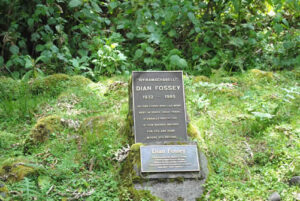 Dian was found dead in her cabin at the Karisoke center on the morning of 27th December 1985. On her lifeless body were marks of a machete which were proof that she was murdered. There are many theories attempting to explain the cause of the death but many suspect poachers where were not happy with her gorilla conservation efforts. The culprits where never brought to justice. Dian Fossey was buried in a cemetery up the mountains which she had built for the gorillas in her care. She was laid to rest just next to Digit her dear silverback. Today, tourists on gorilla trekking missions in Rwanda also trek the mountain to visit the grave of Dian Fossey. A permit to visit the tomb of Dian Fossey and her former Karisoke research center costs $75.
Dian was found dead in her cabin at the Karisoke center on the morning of 27th December 1985. On her lifeless body were marks of a machete which were proof that she was murdered. There are many theories attempting to explain the cause of the death but many suspect poachers where were not happy with her gorilla conservation efforts. The culprits where never brought to justice. Dian Fossey was buried in a cemetery up the mountains which she had built for the gorillas in her care. She was laid to rest just next to Digit her dear silverback. Today, tourists on gorilla trekking missions in Rwanda also trek the mountain to visit the grave of Dian Fossey. A permit to visit the tomb of Dian Fossey and her former Karisoke research center costs $75.

